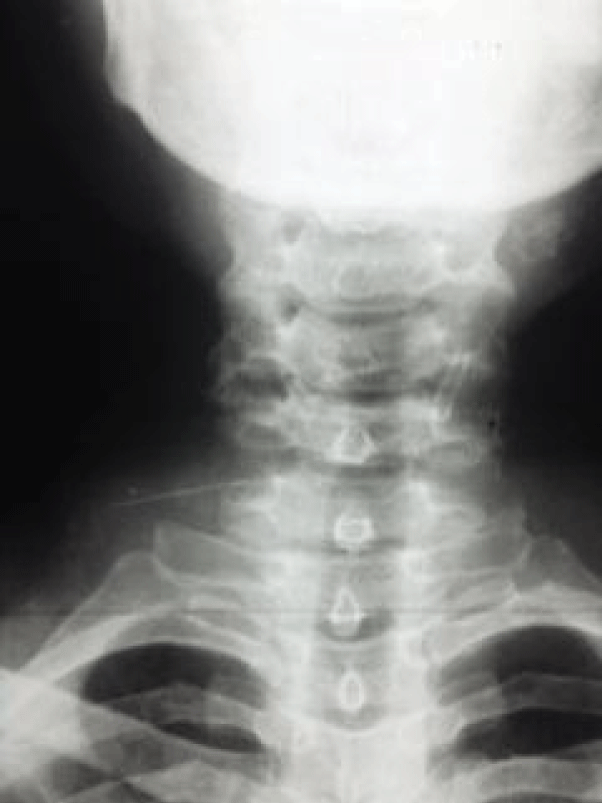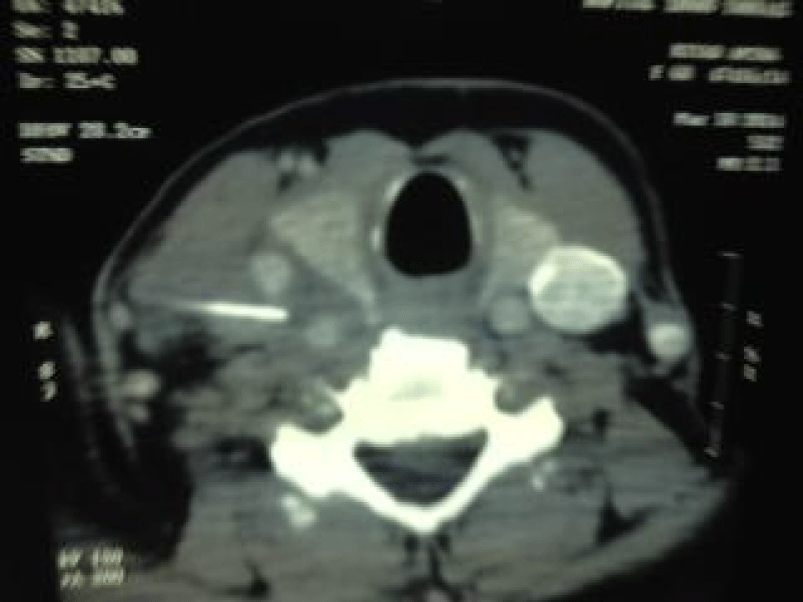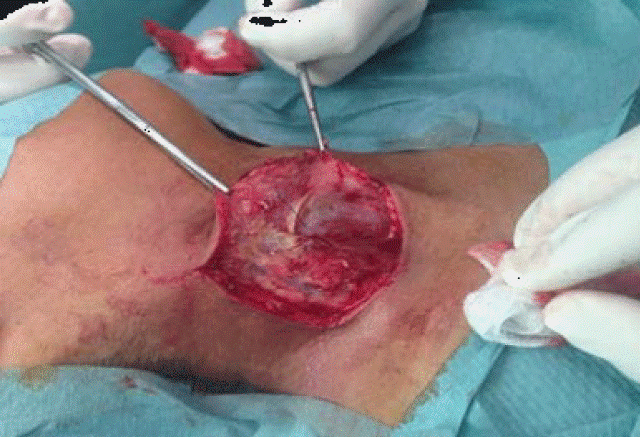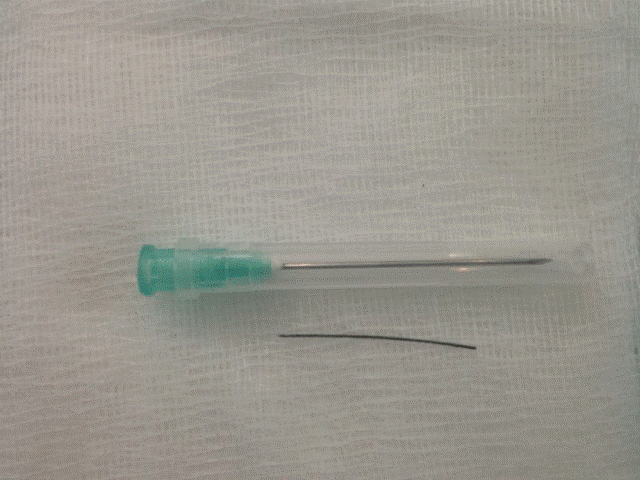A Foreign Body in the Pharynx Migrating through the Internal Jugular Vein: Case Report of Unusual Complication
Received: 16-Mar-2014 / Accepted Date: 15-Jul-2014 / Published Date: 22-Jul-2014 DOI: 10.4172/2161-119X.1000172
Abstract
Foreign body ingestion is a common problem encountered in clinical practice. One of the rare complications of a swallowed foreign body is its migration from the site of entry into the subcutaneous tissues of neck. We report the case of a 57-year old woman who was admitted to our otolaryngology outpatient clinic with a cervical neck mass, with a history of accidental ingestion of a sharp pointed metallic foreign body 2 months earlier. Cervical X-rays and Computed Tomography (CT) scan was then done that showed a 2-cm long metallic foreign body in the subcutaneous tissues of neck. The Doppler ultrasound showed a large thrombus occluding the right internal jugular vein. The foreign body was easily removed under general anesthesia. Postoperative period was uneventful and the patient was doing well on follow-up without any complications.
Keywords: A Foreign body, The internal jugular vein, Migration
246525Introduction
Foreign bodies of pharynx and esophagus are encountered in otolaryngology practice. One of the rare complications of a swallowed foreign body is its migration from the site of entry into the subcutaneous tissues of neck which requires immediate attention and treatment. We present a case of a sharp metallic foreign body, which migrated from pharynx through the subcutaneous tissues of neck and penetrated the internal jugular vein.
Case Report
We report the case of a 57-year old woman who was admitted to our ENT outpatient clinic with a cervical neck mass without other signs and symptoms. The patient history revealed that she had previously been treated several times for odynophagia with cervical tumescence, with a history of accidental ingestion of a sharp pointed metallic foreign body 2 months earlier.
Otolaryngological examination revealed a firm lateral cervical mass without any other abnormalities. Flexible fibreoptic endoscope of laryngopharynx showed a pooling of saliva at the right pyriform fossa. Neck xray revealed a radio-opaque metallic foreign body in the soft tissues of the neck at the level of C5-6 vertebrae (Figure 1).
A Computed Tomography (CT) scan was then done that showed a 2-cm long metallic foreign body in the subcutaneous tissues of neck at the level of C5-6 vertebrae traversing the internal jugular vein with thrombosis of the vein (Figure 2).
The Doppler ultrasound showed a large thrombus occluding the right internal jugular vein. The thrombus is seen as echogenic material distending the lumen of the right Internal Jugular Vein (IJV).
An emergency neck exploration was performed under general anaesthesia through a lateralcervical incision. After incising the skin and subcutaneous tissue, the sternocleidomastoid muscle was retracted laterally. A metallic forgein body was found piercing the internal jugular vein (Figure 3 and 4). The foreign body was withdrawn without any bleeding because of thrombosis of the internal jugular vein. The sternocleidomastoid muscle was sutured back, and the wound was closed in layers. Treatment of the thrombus was based on five days of heparin therapy followed by three months of aspirin.
Postoperative period was uneventful and the patient was doing well on follow-up without any complications.
Discussion
Accidental ingestion of foreign bodies is a relatively common presentation at any otorhinolaryngology clinic [1-3].
These foreign bodies usually get impacted along the upper digestive tract at the tonsils, vallecula and cricopharynx and are easily removed via a flexible or rigid endoscopy [1-3]. However, sharp and pointed foreign bodies get impacted in the surrounding walls of the lumen. The mechanism by which these foreign bodies propelled through the soft tissues is due to movement of neck muscles and combination of esophageal peristalsis [2,4].
Some authors think that carotid pulsations, tissue reaction as well as infection and abscess formation could also play a role in migration of foreign bodies [1,3,4].
Generally, a swelling in the neck after a history of impaction of foreign body must alert the surgeon of the possibility of perforation and migration of the foreign body into the soft tissues of the neck with subsequent infection and inflammation, and can cause potentially fatal complications depending on the direction and site of the migration [2,4].
Tsunoda et al. [5] reported a pseudo vocal paralysis caused by a fish bone lodged between the arytenoid cartilage and the thyroid cartilage, making it impossible for the arytenoid cartilage to rotate. Another postulation was neuropraxia of right vagus nerve in carotid sheath while manipulations to remove the fish bone as the right vagus nerve was identified and preserved introperatively [1,5].
Hypopharyngeal foreign bodies are usually found intraluminally, cases with extraluminal foreign body has been reported rarely in the literature. A plain radiograph is usually used to confirm the diagnosis of an ingested metalic forgein body, but the diagnosis and the exact location of these extraluminal foreign bodies and its relation to the vital structures can be established with CT scan of neck which provides a roadmap for surgical intervention.wich was imperative in our case [1,2,5,6].
Generally, immediate localization and removal of all foreign bodies in the upper aerodigestive tract is imperative, particularly in cases of migrating sharp foreign bodies to prevent secondary complications of haemorrhage, haematoma, infection, neurovascular compromise, and the potential migration into the vascular structures [1,2,6]. In our case we were able to remove it easily without any bleeding because of thrombosis of the internal jugular vein.
Conclusion
Foreign body ingestion is a common problem encountered in clinical practice. Most of them pass spontaneously but some are really problematic. The possibility of perforation and migration of the foreign body in the soft tissues of the neck must always be borne in mind especially if the patient presents with a tender neck swelling. Though these are rare occurrences, prompt investigation and appropriate treatment should be instituted to avoid complications associated with its subsequent migration. Therefore, a CT scan of the neck preoperatively is helpful in locating the site of penetration and the direction for the search.
References
- Tang IP, Singh S, Shoba N, Rahmat O, Shivalingam S, et al. (2009) Migrating foreign body into the common carotid artery and internal jugular vein--a rare case. AurisNasus Larynx 36: 380-382.
- Sharma NK, Yadav VK, Pokharna P, Devgaraha S, Mathur RM (2013) Surgical management of an impacted sharp mettalic foreign body in esophagus. International Journal of Case Reports and Images 4: 463-466.
- Pang KP, Pang YT (2002) A rare case of a foreign body migration from the upper digestive tract to the subcutaneous neck. Ear Nose Throat J 81: 730-732.
- Joshi AA, Bradoo RA (2003) A foreign body in the pharynx migrating through the internal jugular vein. Am J Otolaryngol 24: 89-91.
- Akulwar Lt Col AV, Dwivedi MG, Dwivedi MD (2010) Migrating Extraluminal Foreign Body Hypopharynx. MJAFI 66 : 196-197.
- Tsunoda K, Sakai Y, Watanabe T, Suzuki Y (2002) Pseudo vocal paralysis caused by a fish bone. Lancet 360: 907.
Citation: Adil T, Btissam B, Othmane B, Hassane N, Youssef R, et al. (2014) A Foreign Body in the Pharynx Migrating through the Internal Jugular Vein: Case Report of Unusual Complication. Otolaryngology 4:1000172. DOI: 10.4172/2161-119X.1000172
Copyright: © 2014 Adil T, et al. This is an open-access article distributed under the terms of the Creative Commons Attribution License, which permits unrestricted use,distribution, and reproduction in any medium, provided the original author and source are credited.
Select your language of interest to view the total content in your interested language
Share This Article
Recommended Journals
Open Access Journals
Article Tools
Article Usage
- Total views: 15372
- [From(publication date): 8-2014 - Jul 09, 2025]
- Breakdown by view type
- HTML page views: 10767
- PDF downloads: 4605




